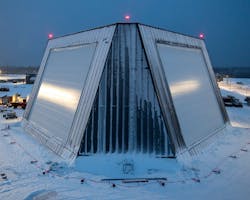Space Force asks InDyne to upgrade SSPARS space surveillance radar with more missile-defense capability
PETERSON SPACE FORCE BASE, Colo. – U.S. Space Force radar experts needed a company to upgrade a global distributed radar network that provides missile-defense and early warning of enemy ballistic missile launches and potential threats in space. They found their solution from InDyne Inc. in Lexington Park, Md.
Officials of the U.S. Space Force Space Operations Command's Space Acquisition & Integration Office at Peterson Space Force Base, Colo., announced a $12.9 million order to InDyne earlier this month to add capability to the Solid State Phased Array Radar Systems (SSPARS).
These radar systems -- once referred to as the Phased Array Warning System (PAVE PAWS) and the Ballistic Missile Early Warning System (BMEWS) -- represent a radar, computer, and communications system for missile warning and space surveillance.
InDyne experts will add missile-defense radar organizational maintainer and system administrator support to the Long-Range Discrimination Radar, a system that is on the SSPARS contract. Work will involve the SSPARS site at Clear Space Force Station, Alaska.
Related: Radar keeps a surveillance eye on the battlefield
SSPARS sites are located at five separate locations: Beale Air Force Base, Calif.; Cape Cod, Space Force Station, Mass.; Clear Space Force Station, Alaska; Royal Air Force Station Fylingdales, England; and Pituffik Space Base, Greenland.
Air Force radar experts have been considering technology refresh for the front-end and remoting capabilities of those radar systems, and have received significant upgrades to their data- and signal-processing subsystems.
The SSPARS ballistic missile-defense radar provides U.S. Strategic Command (USSTRATCOM) at Offutt Air Force Base near Omaha, Neb., with warning and attack-assessment information on all intercontinental ballistic missiles (ICBMs) launched throughout the world that might be headed for U.S. territory.
The system also helps warn USSTRATCOM and NATO authorities of submarine- and sea-launched ballistic missile (SLBM) attacks and provides data to help evaluate the severity of ballistic missile attacks.
A sister system -- the Perimeter Acquisition Radar Attack Characterization System (PARCS) is a large radar installation in North Dakota that provides ballistic missile warning and attack assessment, as well as space surveillance data to the North American Aerospace Defense Command (NORAD) at Peterson Space Force Base, Colo., as well as to USSTRATCOM and regional combatant commanders.
The Long Range Discrimination Radar (LRDR) in Alaska is part of the U.S. Ground-Based Midcourse Defense anti-ballistic missile system. LRDR is a gallium nitride (GaN)-based, solid-state active electronically scanned array (AESA) early-warning radar.
LRDR consists of individual solid state radar blocks that can combine to scale-up the size of the radar. Each of the system's AESA radar faces are 60 feet high by 60 feet wide that provide a 220-degree field of view.
On this order InDyne will do the work at Clear Space Force Station, Alaska, and should be finished by October 2026. For more information contact InDyne Inc. online at www.indyneinc.com, or Space Force Space Operations Command at www.spoc.spaceforce.mil.
